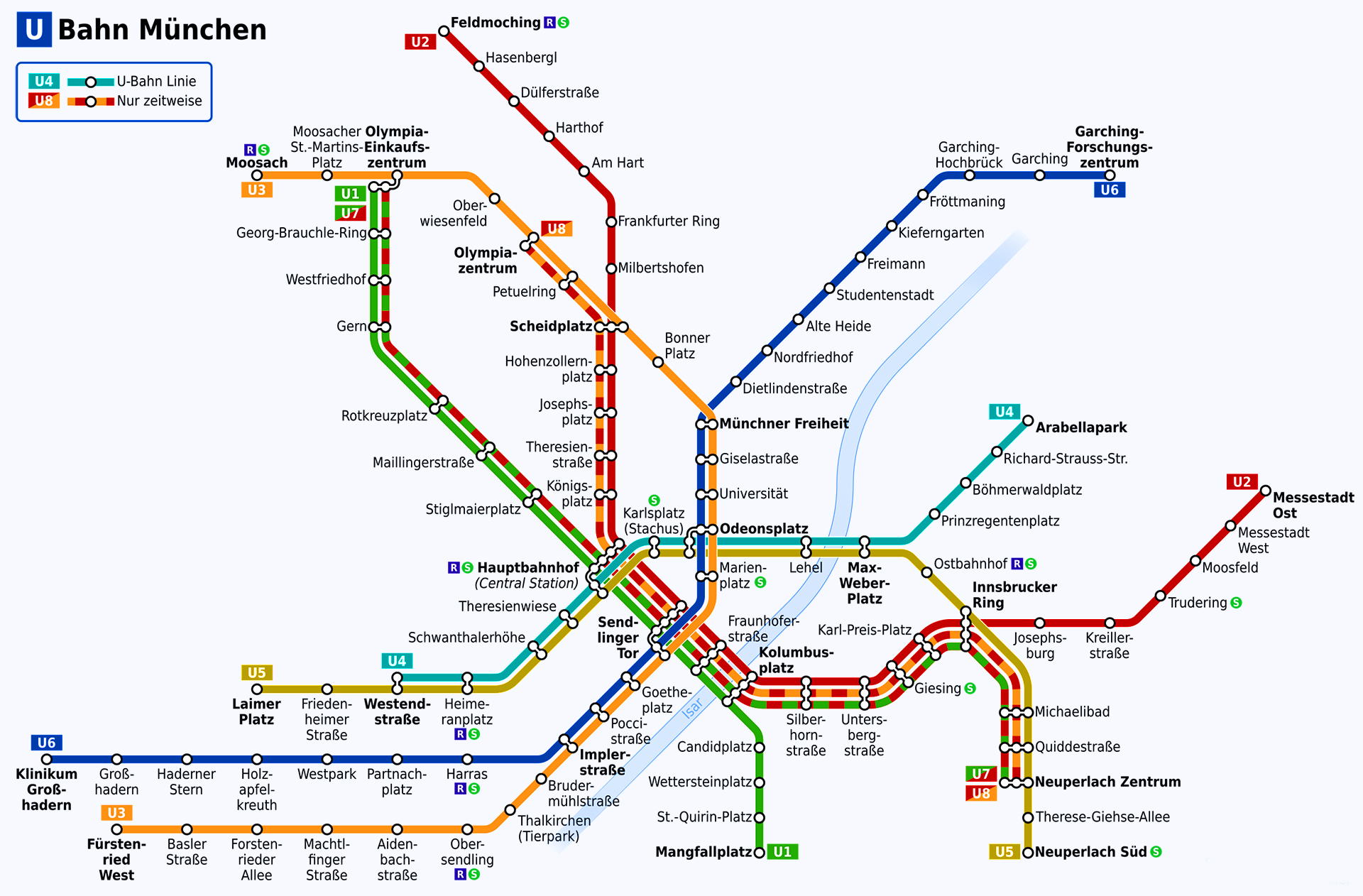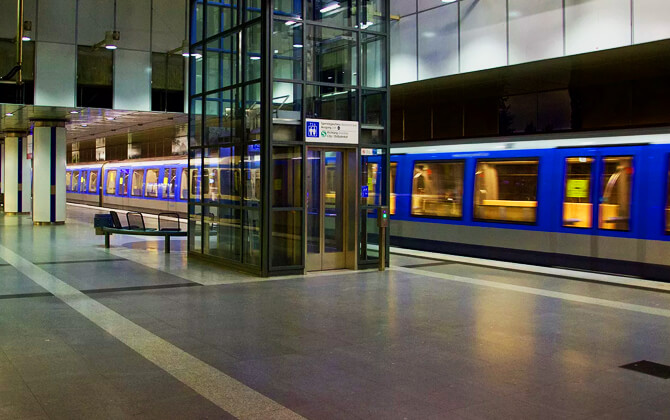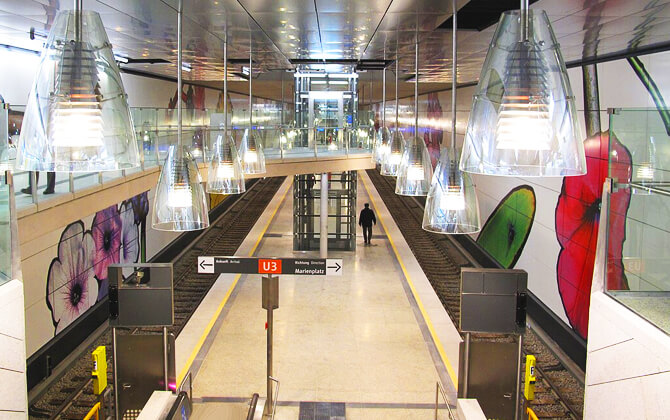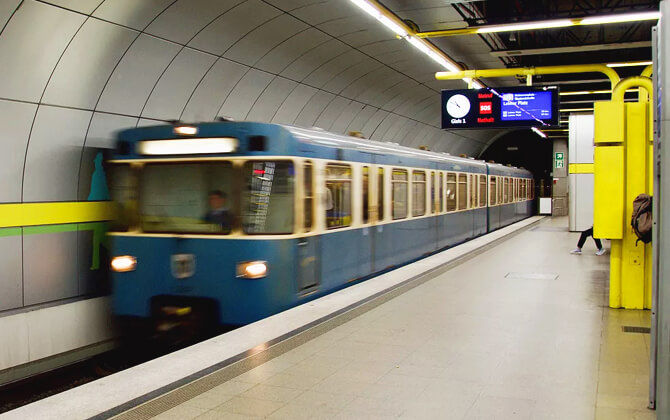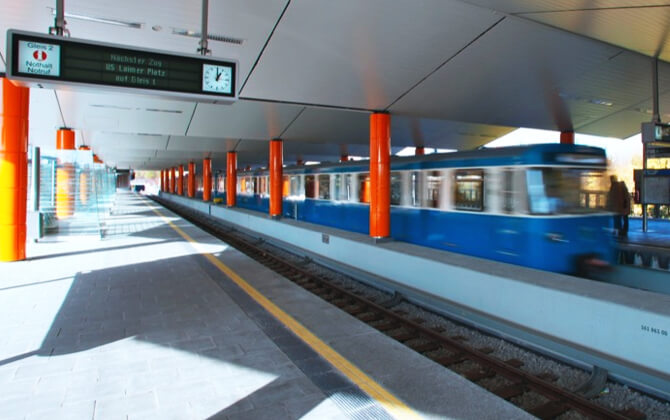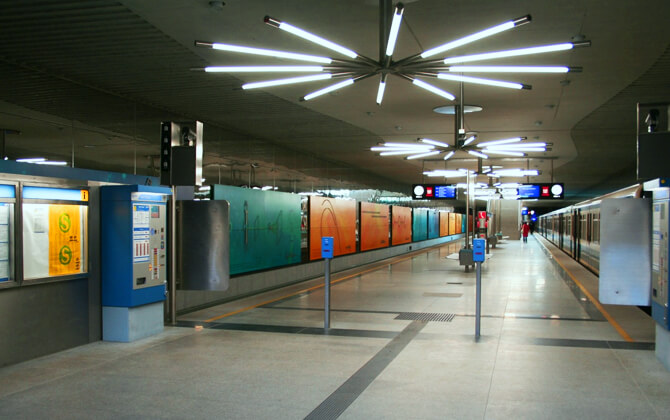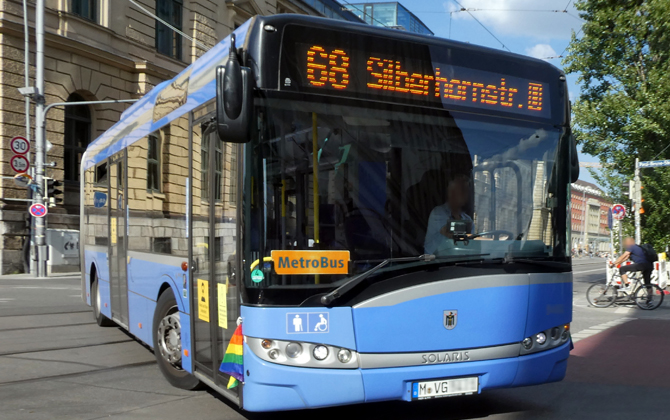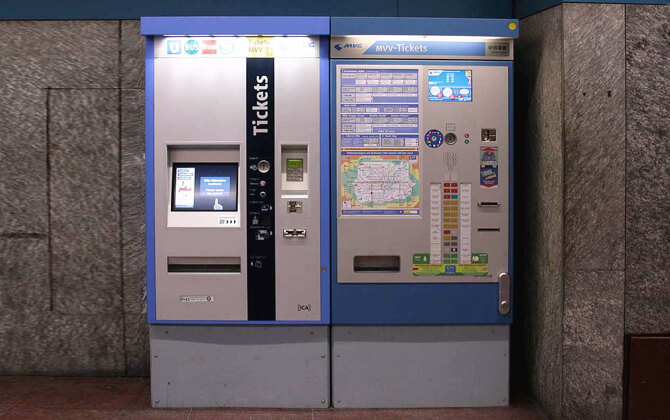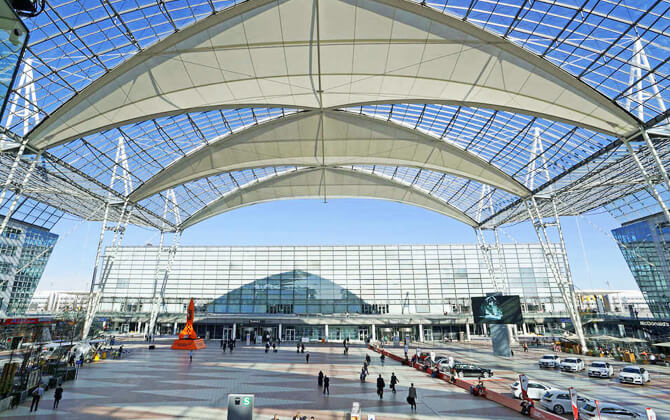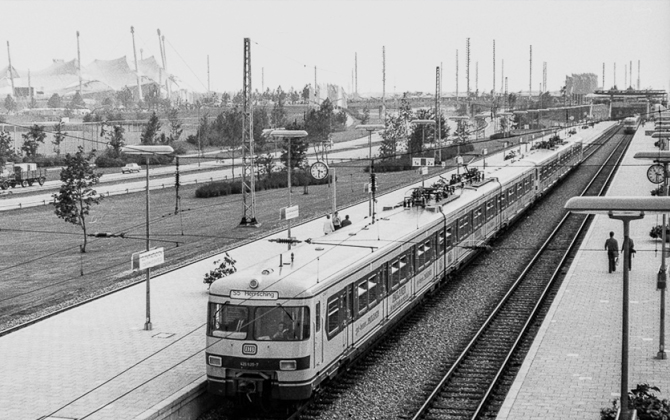Munich U-Bahn (metro) is a fast, electric underground rail network that forms the backbone of the city’s public transport. It opened in 1971 and now has 8 lines (U1–U8) serving most of Munich. It links with the S-Bahn, trams, and buses under the MVV fare system, so you can transfer on one ticket. The network stretches from Garching-Forschungszentrum in the north to Klinikum Großhadern in the south, and from Moosach in the west to Messestadt Ost in the east. Each line has its own number and color. Stations have announcements in German and English, and all signs are bilingual. Many stops feature unique architecture or artwork. The Munich metro system is safe, clean, and reliable, with frequent service in the city center.
Below you will find a Munich U-Bahn map 2025, line and station details, timetables, fares in EUR and USD, tips, airport links, park-and-ride info, future plans, and a brief history.
Munich U-Bahn Map 2025
The U-Bahn network has 8 lines in 2025. Lines U1–U6 run all day. Lines U7 and U8 run only in peak hours. Each line has a color: U1 green, U2 red, U3 orange, U4 turquoise, U5 brown, U6 blue, U7 and U8 grey or dashed. The Munich metro map shows all lines, stations, and connections. It marks S-Bahn interchanges with “S” symbols. Tram stops appear near U-Bahn exits.
In the city center, three main trunks cross. One trunk runs north-south through Hauptbahnhof and Sendlinger Tor for U1/U2. Another goes via Odeonsplatz and Marienplatz for U3/U6. The third passes Karlsplatz (Stachus) and Lehel for U4/U5. These meeting points make transfers easy. For example, Marienplatz offers cross-platform change between U3/U6 and the S-Bahn. Sendlinger Tor links U1/U2 with U3/U6 on different levels.
Some stations act as hubs: Hauptbahnhof (U1/U2 and U4/U5 plus S-Bahn), Marienplatz (U3/U6 plus S-Bahn), Sendlinger Tor, Odeonsplatz (U3/U6 and U4/U5), Scheidplatz (U2 and U3/U8), and Innsbrucker Ring (U2/U7 and U5). These are highlighted on the map.
The Munich subway map shows MVV fare zones. Zone M covers Munich city. Outer zones are rings 1–6. Most U-Bahn stations lie in Zone M. A few at the outskirts, like Garching on U6, lie in outer zones.
Recent changes appear on the 2025 map. It shows the U5 extension toward Pasing (dotted west of Laimer Platz) and the proposed U9 line (dashed from Münchner Freiheit to Implerstraße).
Munich U-Bahn Map 2025 showing different lines. Click on the map to enlarge it or download the Munich U-Bahn Map in PDF format.
Lines & Stations
Line U1
Overview: U1 runs from Olympia-Einkaufszentrum (OEZ) in the north to Mangfallplatz in the south, covering 12.2 km and 15 stations. It serves central Munich via Hauptbahnhof and Sendlinger Tor and is shown in green on network maps. U7 shares the northern section of this route.
Olympia-Einkaufszentrum (OEZ) – The northern terminus sits beneath a major shopping centre. Opened in 2004, it features side platforms and direct connections to U3. Nearby are the Olympia Shopping Mall and the Olympic Village housing estate.
Georg-Brauchle-Ring – Opened in 2003, this station is known for its colorful modern murals. It lies beside insurance offices and offers easy access to the western edge of Olympiapark.
Westfriedhof – Famous for its dramatic dome lamps in blue, red and yellow, this 1998 station serves the Nymphenburg district and provides P+R parking.
Gern – A quiet, residential stop opened in 1998 with a vaulted pyramid ceiling. It connects to the München-Nymphenburg Canal area via ramps and stairs.
Rotkreuzplatz – Serving Neuhausen since 1983, this station has a pillar-free hall and tram stops for lines 12, 20 and 21 at street level.
Maillingerstraße – Located in Maxvorstadt/Neuhausen, this 1983 station sits beneath a street lined with military administrative offices.
Stiglmaierplatz – Opened in 1983, it offers access to the Kunstareal museum quarter and connections to tram 20/21. A short walk leads to the Löwenbräukeller beer hall.
Hauptbahnhof – Underneath Munich’s main train station, U1 and U2 use separate deep platforms with four tracks. From here you can switch to long-distance trains, S-Bahn (S1–S8), U4/U5 and local buses.
Sendlinger Tor – A major transfer hub where U1/U2 meet U3/U6. The lower level serves U1/U2 and the upper level U3/U6. Exits lead to the old town and several tram lines.
Fraunhoferstraße – Deep beneath the Isar, this station opened under the Fraunhofer Society building. It’s a gateway to the lively Glockenbachviertel cafés and the Gärtnerplatz theatre district.
Kolumbusplatz – A unique three-track layout where U1 and U2 split. U1 uses a side platform for outbound and shares the central platform inbound. Surface buses connect here.
Candidplatz – Famous for its rainbow-coloured mosaic, this 1997 station serves the Giesing district and sits near the Isar riverbank park.
Wettersteinplatz – A straightforward 1970s-style station serving sports grounds, including a swimming pool and TSV 1860 Munich’s stadium.
St.-Quirin-Platz – Noted for its curved glass roof that floods the platform with natural light. It serves a quiet residential area and a small park.
Mangfallplatz – The southern terminus opened in 1997 in Neuharlaching. It has a single island platform and bus links to Grünwald and Großhesselohe.
Line U2
Overview: U2 runs from Feldmoching in the north to Messestadt Ost in the east, spanning about 24 km and 27 stations. Shown in red, it serves key locations such as the Tech University, Königsplatz museums and the Trade Fair Centre.
Feldmoching – Northern terminus with P+R parking and interchange to S-Bahn S1 and regional trains. The bright mezzanine overlooks the ground-level tracks.
Hasenbergl – Opened in 1993, its reflective canopy ceiling and blue design serve a large residential area with nearby shops and community centres.
Dülferstraße – Also from 1993, this station features colorful walls and a mezzanine balcony. It serves the Am Hart housing estate.
Harthof – The north-south mezzanine allows daylight down to the platform. It opened in 1993 and sits beneath the Harthof district.
Am Hart – Known for its wing-shaped ceiling design, this 1993 station connects to Siemens offices and bus routes into the Euro-Industriepark.
Frankfurter Ring – Under a busy road, it boasts a very high platform hall and serves nearby automotive offices and hotels.
Milbertshofen – Close to BMW World & Museum and Olympiapark. Opened in 1993 with distinctive neon lighting.
Scheidplatz – Cross-platform transfers link U2, U3 and U8. Opened in 1972 in Schwabing-West.
Silberhornstraße – An open, column-free design in Giesing with surface access to the Giesinger Bräu brewery and tram 25.
Untersbergstraße – A small 1980 station in Obergiesing with a single mezzanine and bus connections.
Giesing (Bahnhof) – Integrated U-Bahn/S-Bahn interchange with regional trains and a bus terminal serving southern suburbs.
Innsbrucker Ring – Cross-platform transfers to U5 (and U7/U8 when running). Four tracks under a busy ring road.
Trudering – Above-ground interchange with S-Bahn S4/S6 and park-and-ride. Serves residential and commercial areas.
Messestadt Ost – Eastern terminus at the Trade Fair entrance. Long platforms handle event crowds and link directly to exhibition halls.
Line U3
Overview: U3 stretches from Moosach in the north-west through the city centre to Fürstenried West in the south-west. Covering about 21 km with 25 stations and shown in orange, it stops at major tourist and university hubs.
Moosach – Northern terminus and S-Bahn S1 interchange, integrated with the tram network and shopping centre above. Park & Ride available.
Olympiazentrum – Opens to the Olympic Park, Stadium, Olympiahalle and BMW Welt. The 1972 station has vaulted ceilings and event-day crowds.
Münchner Freiheit – Bustling Schwabing hub with U6 interchange, neon lighting and direct exits to a busy bus and tram hub.
Universität – Adorned with academic art, this station serves LMU’s main campus and nearby Geschwister-Scholl-Platz.
Odeonsplatz – Two-level interchange with U4/U5 above and U3/U6 below. Exits lead to the Residenz, Hofgarten and the old town.
Marienplatz – City centre under the main square. Island platform for U3/U6 and deep S-Bahn below. Direct access to City Hall and Frauenkirche.
Goetheplatz – Serves Glockenbachviertel and is a short walk from the Oktoberfest grounds and the Verkehrszentrum museum.
Poccistraße – Near administration offices and the Oktoberfest field. Useful alternative stop during the festival.
Implerstraße – Divergence point for U3 and U6, with stacked island platforms and a busy bus hub at street level.
Thalkirchen (Tierpark) – Gateway to Hellabrunn Zoo with animal-themed decor and a dedicated storage track for off-peak trains.
Fürstenried West – Southern terminus with park-and-ride and suspended ceiling canopies, serving large residential estates.
Line U4
Overview: U4 links Westendstraße in the west to Arabellapark in the east over 9.2 km and 13 stations. Turquoise on maps, it skirts the city centre and shares most of its route with U5.
Schwanthalerhöhe – Serves Theresienwiese and features industrial-history exhibits. An alternate Oktoberfest stop.
Karlsplatz (Stachus) – Under Stachus square with a vast shopping arcade. Transfers to trams and S-Bahn at surface.
Lehel – Near the English Garden and art museums, this station reflects art nouveau decor and leads to prestigious galleries.
Max-Weber-Platz – Branch point for U4/U5, with direct tram connections and proximity to the Gasteig cultural centre.
Prinzregentenplatz – Close to the Prinzregenten Theater and Friedensengel monument, with minimal-pillar design fitting the upscale locale.
Arabellapark – Eastern terminus in a business and hotel district. Features a large bus terminal and direct access to major hotels.
Line U5
Overview: U5 runs from Laimer Platz in the west to Neuperlach Süd in the south-east, covering 15 km and 18 stations. On maps it’s brown and shares the west section with U4 before branching via Ostbahnhof to Neuperlach.
Laimer Platz – Western terminus in Laim. Opened in 1988 with a simple design and one main exit. A small bus station (Bus 51) sits above. Future extensions to Pasing begin in 2025.
Friedenheimer Straße – Just east of Laimer Platz, opened 1988. Under the eponymous road, it serves local housing and a sports complex. Bus 51 stops nearby.
Westendstraße – Shared with U4, this through station marks where U5 continues east.
Schwanthalerhöhe – Shared with U4, it serves Oktoberfest grounds and industrial-history exhibits.
Theresienwiese – Shared with U4, direct access to the festival field. Expect heavy crowds during Oktoberfest.
Hauptbahnhof – Shared with U4, U4/U5 platforms lie under the main station concourse. Follow signs to U5 toward Neuperlach Süd.
Karlsplatz (Stachus) – Shared with U4, this busy interchange sits beneath the pedestrian zone, linking to trams and S-Bahn.
Odeonsplatz – Shared with U4, two-level transfer to U3/U6 below. Exits lead to the Residenz and Hofgarten.
Lehel – Shared with U4, stops for the English Garden and nearby museums.
Max-Weber-Platz – Here U5 diverges southeast. It’s a tram hub and close to the Gasteig cultural centre.
Ostbahnhof – Major interchange beneath Munich East station. Connect to S-Bahn (S1–S8), regional trains, Tram 19/21, and buses. Shops and eateries in the terminal above.
Innsbrucker Ring – Shared with U2 and U7/U8. Four tracks allow cross-platform transfers to U2 toward Messestadt or U5 toward Neuperlach.
Michaelibad – Serves the Michaelibad swimming pool. Opened in 1988 with a green theme. Bus 155/195 interchange.
Quiddestraße – Local stop under Quiddestraße, opened 1988. Surrounded by 1970s residential blocks and a small shopping centre.
Neuperlach Zentrum – Adjacent to the PEP shopping mall and library. U7 peak service often terminates here. Bus terminals connect to suburban routes.
Neuperlach Süd – Southeastern terminus and S-Bahn S7 interchange. Open-air station at ground level, with P+R and bus links to Ottobrunn and beyond.
Line U6
Overview: U6 stretches 27.4 km from Garching-Forschungszentrum in the north to Klinikum Großhadern in the southwest, serving 26 stations. It’s blue and shares the city-centre trunk with U3.
Garching-Forschungszentrum – Northern terminus at the research campus. Open-cut station opened 2006, busy with students and scientists.
Garching – Underground stop serving the town square, restaurants and buses to nearby villages.
Garching-Hochbrück – Ground-level station with large P+R beside the A9 motorway and nearby retail outlets.
Fröttmaning – Above-ground station for Allianz Arena events, with two island platforms and multi-storey P+R parking.
Kieferngarten – Original U6 terminus opened 1971, still retains a vintage feel and P+R parking for event overflow.
Freimann – Surface station serving local industry and depot, quiet outside peak hours.
Studentenstadt – Above-ground stop for student housing, lively at night and close to the English Garden.
Alte Heide – Schwabing station with straightforward 1970s design beneath Ungererstraße.
Nordfriedhof – Island platform under the Northern Cemetery and office towers, with bus links to the airport shuttle.
Dietlindenstraße – Small stop near residential streets and a hidden English Garden entrance.
Münchner Freiheit – Shared with U3, a neon-lit Schwabing interchange to U6 and trams.
Giselastraße – Shared with U3, serves restaurants along Leopoldstraße.
Universität – Shared with U3, adorned with academic art at LMU campus.
Odeonsplatz – Shared with U3/U4, two-level transfer hub under the historic square.
Marienplatz – Shared with U3, central square station above the S-Bahn hub and beneath City Hall.
Sendlinger Tor – Shared with U1/U3, main transfer point with tram connections.
Goetheplatz – Shared with U3, closest U6 stop for Oktoberfest grounds after a short walk.
Poccistraße – Shared with U3, near Oktoberfest’s south end, used as an alternate festival stop.
Implerstraße – Shared with U3, stacked platforms where U6 diverges south.
Harras – Sendling interchange with S-Bahn S7 and bus routes, busy local centre.
Partnachplatz – Station serving Westpark residential area and park entrance.
Westpark – Direct exit into Westpark gardens, opened 1989 with nature-themed art.
Holzapfelkreuth – Quiet stop in Hadern residential quarter, opened 1991.
Haderner Stern – Under a small shopping centre, with P+R and bus links to Großhadern.
Großhadern – Near the beer garden and church, serving a family-oriented neighbourhood.
Klinikum Großhadern – Southern terminus at the university hospital, with direct clinic access, elevators and medical-themed art.
Line U7
Overview: U7 runs weekdays at peak between Olympia-Einkaufszentrum and Neuperlach Zentrum. It follows U1 to Hauptbahnhof, U2 to Innsbrucker Ring, then U5 to Neuperlach Zentrum, providing a one-seat ride across town without exclusive stations.
Line U8
Overview: U8 offers limited weekend and peak shuttles. On weekends it runs from Olympiazentrum to Sendlinger Tor via Petuelring and Scheidplatz; at busy weekday times it shuttles Oberwiesenfeld to Scheidplatz, easing north-city crowding on U2/U3.
Connections to S-Bahn, Trams & Buses
You can use one ticket for U-Bahn, S-Bahn, trams, and buses. Key S-Bahn interchanges are Hauptbahnhof (U1/U2/U4/U5), Marienplatz (U3/U6), Ostbahnhof (U5), Sendlinger Tor, Harras (U6), München-Giesing (U2), Neuperlach Süd (U5), Moosach (U3), and Feldmoching (U2). From these stops, you can reach the airport and outer towns.
Trams cover areas without U-Bahn service. Many stations have tram stops nearby. For example, Sendlinger Tor has trams 16, 17, 18, and 27. Karlsplatz (Stachus) has trams 16, 17, 19, 27, and 28. Münchner Freiheit is the terminus of tram 23. All trams use MVV tickets.
Buses serve most U-Bahn stations. Stops are near exits. Oberwiesenfeld has buses to Olympia Pressestadt. Münchner Freiheit has routes across Schwabing and express lines like X30. Ostbahnhof has city and regional buses. City lines are numbered 50–199, express X lines, and regional 200+.
The Lufthansa Express Bus runs from Nordfriedhof (U6) to the airport every 20 minutes. Ostbahnhof also has an airport bus. For direct airport travel, the S-Bahn S1 and S8 are faster.
After U-Bahn stops, night buses cover routes. Tram N27 and buses N40–N45 run at night. Use MVG Fahrinfo or the MVV planner to plan trips.
Munich U-Bahn Operating Hours, Timetable & Frequency
The U-Bahn runs daily from around 4:00 AM to 1:00 AM. On weekdays, service starts at 4:00–4:30 AM and most trains run by 5:00 AM. Last trains leave downtown at about 12:30–1:00 AM. After that, night buses take over.
If you’re looking for Munich U-Bahn hours, note that Friday and Saturday nights offer extended service until about 2:30 AM. They pause for maintenance around 3:00–4:00 AM. Night buses N40–N45 fill in after.
During rush timings (6:00–9:30 AM and 3:00–6:30 PM), trains come every 5 minutes on core sections. In peak overlaps, you may see trains every 2 minutes. Outside rush, lines run every 10 minutes. Late evenings and early mornings drop to 15–20 minutes.
Platforms show digital countdowns to the next train. The Munich U-Bahn schedules are synced. Trains often arrive at the same minute each hour. For early or late trips, check the MVV or MVG apps. On holidays, service follows the Sunday schedule. New Year’s Eve may have all-night runs. On Christmas Eve, service ends early.
Each line has its own frequency. U1, U2, U3, and U6 run most often. U4 may run every 20 minutes in the evening. U5, U7, and U8 run as needed in peak times. Check specific line schedules for details.
Munich U-Bahn Fares & Tickets
Munich U-Bahn fare is zone-based under the MVV system. Your Munich U-Bahn ticket price depends on how many zones you cross. All tickets work on U-Bahn, S-Bahn, tram and bus.
Single Ticket (Einzelfahrkarte)
One-way journey, valid 3 hours (one direction), transfers allowed.
| Zones | Price (€) | Approx. USD |
|---|---|---|
| Zone M or 2 zones | 4.10 | 4.50 |
| 3 zones | 6.10 | 6.70 |
| 4 zones | 8.10 | — |
| 5 zones | 10.20 | — |
| 6 zones | 12.20 | — |
| All zones (M+6) | 26.50 | — |
- Children (6–14): €1.90
- Under 6: Free
- Short Trip (Kurzstrecke): Up to 3 U-Bahn/S-Bahn stops or 6 tram/bus stops. €2.00
Stripe Ticket (Streifenkarte)
Prepaid 10-ride paper card. Punch stripes per trip:
- Adult: €17.80 (10 stripes)
- U21 (15–20 years): €9.80 (10 stripes)
Use 2 stripes for Zone M or 2 zones; add 1 stripe per extra zone. Stamp in blue validators before travel.
IsarCard Weekly Pass
- Zone M: €22.40
- Zone M+5: €75.90
Unlimited rides for 7 days from activation. Write your name; ID checks possible.
IsarCard Monthly Pass
- Zone M: €68.40
- “9 Uhr” (after 9 AM weekdays): €60.90
Valid 30 days from purchase. Non-transferable; write your name.
Day Passes, Group Tickets & Munich U-Bahn Fare Calculator
- Single Day Ticket: Zone M: €9.70 (valid until 6 AM next day)
- Group Day Ticket (up to 5 people):
- Zone M: ≈ €18.00
- Zone M-5: €30.50
- Airport City Day Ticket: All zones: €15.90 (single) / €27.00 (group)
- Children Day Ticket (6–14): €3.70 (all zones)
- CityTourCard / München Card: Transport + discounts; varies by duration.
- Munich XXL Ticket: Zone M+1: €11.00 (single) / €20.00 (group)
Use the MVV app or website to calculate your best ticket. Inspectors fine €60 for invalid tickets—always buy and validate.
Using the Munich U-Bahn – Step-by-Step Guide & Travel Tips
Step 1: Plan your route. Check which line (U1–U8) you need and its end station. Use the MVV Journey Planner app or Google Maps.
Step 2: Buy a ticket. At blue machines or in the MVG App, choose single, stripe, day or weekly Munich U-Bahn pass. Validate stripes in the blue “Entwerter” or ensure your pass shows today’s date. You cannot buy on the train.
Step 3: Enter the station. Walk in—no turnstiles. Follow signs for your line and destination. Note exit names so you leave at the right corner.
Step 4: Reach the platform. Look for signs showing line and final stop. If you’re on the wrong side, use the underpass or mezzanine to cross.
Step 5: Wait safely. Stay behind the yellow line. Digital displays show train arrival time and destination.
Step 6: Board the train. Let passengers exit first. On older trains, press the green button to open doors. Check the line and destination on the train before stepping in.
Step 7: Ride and prepare to exit. Inside, follow the route map above the doors. Stops are announced in German and English. Move toward the door one stop before yours.
Step 8: Exit the train. Press the door button on older models. Watch your step. Follow signs to street exits or transfers.
Travel Tips
- Stand on the right side of escalators; walk on the left.
- Keep bags close—pickpockets are rare but possible.
- Bikes allowed off-peak with a €3.50 bike ticket; use end cars.
- Avoid eating on trains—water bottles are fine.
- Use the MVV app to compare ticket options and prices.
Regulations & Safety
Always carry a valid ticket—inspectors fine €60 for no ticket. Smoking and loud music are banned. Leashed dogs need a child ticket; small dogs in carriers ride free. Most stations have elevators, ramps and tactile guides. Emergency call pillars and train intercoms connect you to help. CCTV and staff patrol keep the system safe.
Airport Connection
The U-Bahn does not reach Munich Airport (MUC). Take S-Bahn S1 or S8 from Hauptbahnhof, Marienplatz or Ostbahnhof. Trains run every 10 minutes and take about 40 minutes. Airport is in Zone 5—single ticket €14.30 or Airport City Day Ticket €15.90. Alternatively, the Lufthansa Express Bus (€11) runs from Nordfriedhof (U6) and Hauptbahnhof.
Parking
If you drive to the edge of Munich, you can use Park & Ride (P+R) lots at many U-Bahn and S-Bahn termini. Pay a small fee and ride into the centre on the U-Bahn.
| Station | Lines | Notes |
|---|---|---|
| Fröttmaning | U6 | Large multi-storey, 1 200+ spaces |
| Garching-Hochbrück | U6 | Spacious outdoor lot |
| Fürstenried West | U3 | Covered parking |
| Moosach | U3 / S1 | Shared with S-Bahn |
| Messestadt Ost | U2 | Fairground lot, off-peak parking |
| Neuperlach Süd | U5 / S7 | Large lot |
| Kieferngarten | U6 | Older P+R facility |
Cost is about €1–€1.50 per weekday. Weekends are often free or under €1. Pay at the machine (coins, card, app). Most lots allow 24–48 h stays; for longer, use long-term parking. P+R areas are well lit but not guarded—keep valuables out of sight. On busy days or event days (e.g. football, Oktoberfest), arrive early or have a backup station.
Future Expansions & Planned Lines
Munich is growing its U-Bahn to serve new neighbourhoods and relieve busy routes.
- U5 to Pasing (3.8 km, 3 new stations) – due by 2028.
- U9 relief line (Münchner Freiheit–Implerstraße) – planning in 2025, target early 2030s.
- U6 to Martinsried (+1 km, 1 station) – serves research campus, opens ~2027.
- U4 to Englschalking (3 stations) – in early planning, likely 2030s.
New C2-series trains and signalling upgrades will follow, allowing more frequent and reliable service across the network.
History
Munich’s U-Bahn began in the 1960s to prepare for the 1972 Olympics. Construction started in 1965.
| Year | Event |
|---|---|
| 1971 | First section opens (Kieferngarten–Goetheplatz, now U6) |
| 1972 | Olympia line opens (Münchner Freiheit–Olympiazentrum, now U3) |
| 1980 | Scheidplatz–Neuperlach Süd extension (now U2/U5) |
| 1983–1986 | U1 to Rotkreuzplatz; U6 to Harras; U3 to Poccistraße |
| 1988–1991 | U4/U5 trunks open; U3 reaches Fürstenried West |
| 1993–1999 | U2 to Feldmoching; U6 to Klinikum Großhadern; U2 to Messestadt Ost |
| 2004–2010 | U1 to OEZ; U6 to Garching-Forschungszentrum; U3 rerouted and extended to Moosach |
| 2011–2013 | U7 and U8 introduced to boost peak service |
Since 2010, the focus has been on service tweaks rather than new tracks. The network now has about 96 stations and over 100 km of lines.
